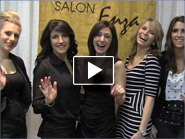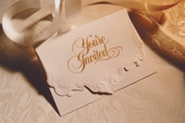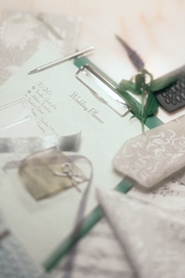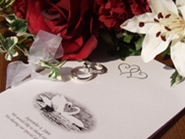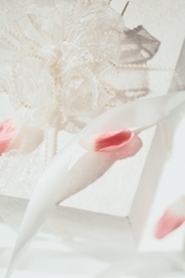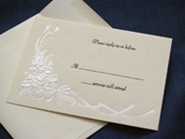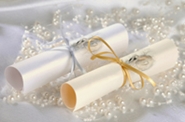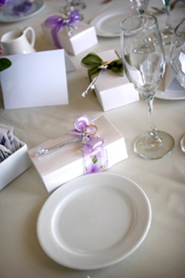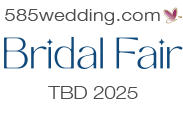Rochester Wedding Invitations
Tips and advice for finding the perfect wedding invitaions for your Rochester wedding
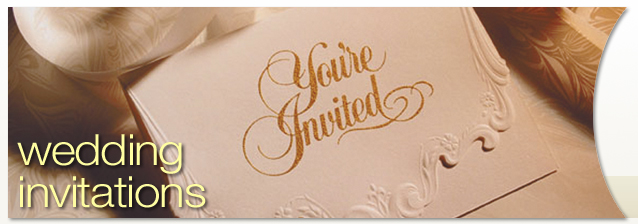
Rochester Wedding Invitations
Your choices in wedding stationery are very important. They give your guests their first impression of your wedding, and may be the keepsakes that are kept the longest.
Look For A Rochester Area Professional Wedding Stationer
Wedding stationery is probably very different from stationery you have used in the past. Most likely you haven’t used formal stationery before. Choose the services of professional stationers who specialize in wedding stationery. They should be best able to provide you with different styles and types of wedding stationery. There are mail-order stationers you can order from, as well.
When To Shop
The wedding invitations and other stationery can be ordered as soon as the wedding and reception sites are booked and confirmed. If you don’t do it right away, they should be ordered at least four months prior to your wedding date.
Wedding Stationery Items
Wedding stationery is much more than just invitations! There are many different items available.
Items and their Purpose
Wedding Invitations: These tell your guests who is hosting the wedding, who is getting married, and the time and date of the wedding ceremony.
Reception Cards: These small cards inform guests of the time, date and location of the reception.
Response Cards, Preprinted Envelopes: You provide these to your guests so that they can indicate how many will be attending, or if they will be unable to come.
Thank You Notepaper: These should be preprinted with your names on the cover, and blank on the inside. If you wish to be less formal, they may simply read “Thank You†on the front, and blank inside.
Wedding Announcements: These are used for informing people not invited to the wedding of your marriage. These people may include business associates, or out-of-town family or friends.
Wedding Programs: These tell guests at the wedding what the sequence of events during your wedding ceremony will be. They can also list the members of your wedding party. Programs are particularly thoughtful if all guests are not familiar with your faith’s wedding service.
Napkins and Matches: These are provided to your reception guests, & as momentos.
“At Home†Cards: These are provided if you want to inform guests of your new address, or if you are moving immediately after your wedding.
Announcement Cards: These are sent to friends and family who are not invited to the wedding. They are only sent after the wedding has taken place.
Favors: Some types of stationery can be provided as a favor to guests, or you can simply have your name printed on tags, to be attached to other favors.
What To Order
Order everything you will need at the same time. You should order about 10% more stationery than you think you will need. This will give some leeway for mistakes in addressing envelopes or forgotten guests. Consider saving leftover napkins to use at future anniversary celebrations. Ordering extra notepaper for Thank You notes is also a good idea. This notepaper, with your names on the front and blank inside, can be used throughout your marriage.
Stationery Terms
You have many, many choices to make. Since your wedding stationery is custom-printed for you, you can select exactly what you want.
Paper: (Also referred to as “stock.â€) Wedding stationery is traditionally printed on white or ivory stock. Colored paper is more contemporary. Paper is priced according to its weight and quality. The heavier paper will be the more expensive. Weight ranges from thin parchment that is nearly transparent to thick vellum.
Printing: The two options available are printing or engraving. Engraving is when the letters are raised on the paper, and ink is applied. Thermo-engraving is less expensive, and still gives a raised appearance. Printing is when the ink is printed on the paper, and is not raised. Most invitations are either engraved or thermo-engraved.
Embossing: This is when letters, borders, or artwork is raised, but ink is not applied.
Handwritten or calligraphy: This is when your invitations are each created individually, by hand. It works well for a small wedding, but may not be practical for a large wedding.
Computer printing: Many different styles of fonts are available on the computer now. You could choose a script type font, for a calligraphic look.
Ink color: The traditional color of ink is black, but colored inks are very commonly seen. You may wish to match the color of your wedding in the ink on the invitations.
Lettering: The stationer should give you the choice of many different type styles to choose from. You should choose a type style which matches your wedding style. If very formal, a Roman style might be appropriate. If less formal, Script-style lettering is very often used. Printers may mention words like serif and san serif. For example, Serif is when letters have curves at the top and bottom of the letters. San serif letters are straighter and less ornate.
Artwork and Borders: Traditionally, the only border used was a raised edge. Now, couples have a very wide variety of art to choose from. The stationer should have many different samples to choose from. Some art is colored, some is raised and not colored. You may choose embossing with gold or silver foil.
Money Saving Tips
- White or ivory paper costs less than colored or parchment.
- Embossing, engraving or printed designs will be more expensive than plain.
- Black or blue ink will be less expensive.
- Photographs and illustrations will increase the cost.
- If every invited to the wedding is also invited to the reception, you can put times and dates of both on the same card, and eliminate the cost of printing and the additional postage for enclosed cards. Be sure to state the time and place of the reception, just as you would have on the separate card.
The Invitation
The wedding invitation consists of one piece of paper, folded in half. Traditionally, the printing appears on the front page, with the inside left blank. You may choose to have artwork or a photograph appear on the front, with the printing on the inside. Invitations come in two sizes: One size is 5†by 7 1/2â€, and is folded a second time to fit into the envelope. The more common size is 4 1/2†by 5 1/2â€, which fits directly into the envelope.
The Wording
Your wedding invitations are formal invitations, and so should follow the traditional phrasing. Of course, as with anything, this is your decision to make. Traditional rules:
- Every name should be written in full, even middle names. Even if everyone you know calls you as “Kathy Smith†your name should be written out in full as “Katherine Ann Smith.†It is acceptable, although it is not traditional, to use middle initials or omit the middle name altogether.
- Family order should be indicated, such as “Jr.†or the Roman numerals “IIIâ€
- All number are written out in full.
- If the bride’s parents are hosting the wedding, the invitation is issued in their names. If both sets of parents are hosting it, both names are used.
- The wording “hounour of your presence†is used for an invitation to a religious ceremony, while “pleasure of your company†is used for a civil ceremony.
- On the wedding invitation, the wording is “The marriage of (bride) to (groom).†On the reception card, the names are linked by the word “andâ€, such as “The reception of (bride) and (groom).â€
- The words “honour†and “favour†are traditionally spelled with the “u†included.
Â
Sample invitation
Now that you’ve heard all the rules, how should they read?
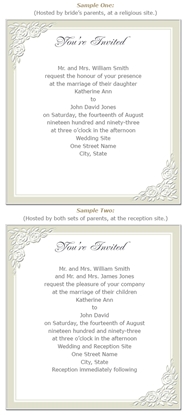
The Envelopes
Wedding invitations are formal invitations, they come with two envelopes. The outer, large envelope is sealed, and is the one which will be addressed and stamped with postage. This envelope is printed with the return address, either on the top left hand corner, or on the back envelope flap. The inner envelope fits snugly inside the outer envelope, and is not sealed. This usually is lined with a colored paper. This envelope contains the invitation and any other enclosures. This envelope is marked with the guests’ names, but not their address. The names on this envelope can be either the same as on the outer envelope, such as “Mr. and Mrs. John Jones,†or they can be more informal, such as “John and Mary.â€
Enclosures
Other enclosures you will probably include in the invitation would be a reception card, announcing when and where the reception will be, a reply card and an envelope to return it in. The response card should have a space for them to fill out if they “Will or Will Not Attendâ€, a number attending, and a space to write the name(s) of the person(s) attending. It should also have a “Respond by†date on it. This date should be approximately a month before your wedding. The return envelope should be stamped and pre-addressed.
Maps
If your wedding or reception sites are difficult to find, or if many of your guests are unfamiliar with the area where you live, it is a courtesy to provide them with maps to all wedding locations. You may wish to draw your own. Appropriate instructions should be either typed or clearly printed on the map. Make sure your directions are clear and easy to follow. You may indicate where they should park, if it is not immediately apparent.
Addressing The Outer Envelope
If you want to get a head start, you may wish to order the invitations as early as possible, or ask the stationer to get the envelopes to you first. This can be a big job, so you may want to ask family or wedding party members to help you with this. Or, you could seek the services of a professional calligrapher. Besides taking a big job off of your shoulders, they can give your envelopes a distinctive look.
Some Guidelines To Follow:
- Most important: Make sure that all names and addresses are accurate, complete, and legible. Include all numbers, such as post office boxes and apartment numbers. If you have any doubts about zip codes, check with the post office.
- Envelopes should be clearly addressed by hand, in either dark blue, black or match the color of the ink on your invitations.
- Write out all names and addresses in full. Don’t abbreviate.
- Numbers should be written as numerals, not in words.
- When two different names are on the envelope, they are written either in alphabetical order, or in order of rank.
- Minor children’s names are not included on the outside envelope.
- Children over sixteen should receive their own invitations.
Addressing Inner Envelopes
These envelopes are addressed with the names of the guests invited. They are usually less formal than the outer envelopes. It is correct to address these with the guests’ names as you normally refer to them. For example, “Mr. and Mrs. Peter Smith†may be addressed as “Uncle Peter and Aunt Maryâ€. This is also where you let your guests know exactly who is invited. If minor children are, their names should appear as well. For example, the envelope could read, “Uncle Peter and Aunt Mary, Jimmy, Janie, and Susie.†If, however, the children are not invited, their names should not appear. This is also where you should let unmarried guests know if they may bring a date with them. For example, it might read, “Miss Mary Doe and Guest.â€
Assembling Invitations
First, put all of your enclosures inside the invitation. Next, place a small piece of tissue paper over the invitation. The stationer should provide this. It is intended to keep the ink from smearing. The invitation is then slid, fold side first, into the inner envelope, with the printing facing up. The inner envelope is slid into the outer envelope with the addressed side facing out, and the flap against the front of the outer envelope.
Mailing
Your wedding invitation, with enclosures and all, may be overweight for a usual postage stamp. To be sure you are putting the correct postage on it, assemble a complete invitation and take it to the post office to be weighed. Also, check to make sure that the reply envelope is proper postage size. Ask the post master if there are any appropriate stamps available, such as the annual “Love†stamp. You will need to purchase postage not only for the invitation itself, but also for the return reply envelope. You may be able to purchase matching stamps for the two envelopes. Also purchase some extra postage for thank you notes, for both pre-wedding and wedding gifts.
When To Mail
Invitations should be put into the mail at least six weeks before your wedding date. You may want to mail them earlier than this if they are going out-of-country, or are being mailed during an especially heavy season, such as during the Christmas holidays. All invitations should be mailed on the same day, so that all guests receive them at approximately the same time. Sometimes, because of money constraints, you will have more people you would like to invite than you can afford to host. If so, it is permissible to send invitations so that they are received two weeks before the wedding.
Responses
You should have received all of your responses back by two weeks before your wedding. If you have not, call any guests who have not responded. The invitation may have gone astray, or they may have forgotten to mail the response card. In any event, make sure they are attending, or not. You will need to know to give a final head count to your caterer or reception site.
Proofreading Checklist
- Is this the correct paper, printing, typeface, ink color?
- Is the printing straight, or out of alignment?
- Is this the correct artwork, border?
- Are the invitations worded properly?
- Are all names spelled correctly?
- Is the time and date correct?
- Is the address correct?
- Is everything spelled out (words, not numbers)?
- Is the punctuation correct, and in the correct places?
- Do the outside envelopes have the correct return address?
- Do the response cards have the correct return address?
- Does the reception card have the correct date and time?
- Does the reception card have the correct address?
- Are the other enclosures correct?
- Does all the stationery match (same paper, ink color, etc.)?
Future Upcoming
Rochester Bridal Shows
![]()
![]()
Click here for your free tickets
![]()
Click here for your free tickets
![]()
Presented by

Rochester's wedding planning site!
![]()
